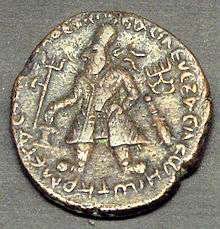Vima Kadphises
| Vima Kadphises | |
|---|---|
| Kushan emperor | |
 Vima Kadphises in long coat. Legend in corrupted Greek script: BACIΛEYC BACIΛEWN CWTHP MEΓAC OOHMO KAΔΦICHC ("Basileus Basileon Sotir Megas Ooimo Kadphisis"): "King of Kings Vima Kadphises the Great Saviour". British Museum. | |
| Reign | 90–100 CE |
| Predecessor | Vima Takto |
| Successor | Kanishka |
Vima Kadphises (Kushan language: Οοημο Καδφισης, Early Middle Chinese: 阎膏珍 pron. jiam-kaw-trin) was a Kushan emperor from approximately 90–100 CE. According to the Rabatak inscription, he was the son of Vima Takto and the father of Kanishka.
Rule
Emperor Vima Kadphises expanded the Kushan territory in Afghanistan, Pakistan and north-west India.
He was the Kushan emperor to first introduce gold coinage, in addition to the existing copper and silver coinage. Most of the gold seems to have been obtained through trade with the Roman Empire. The gold weight standard of approximately eight grams corresponds to that of Roman coins of the 1st century. Gold bullion from Rome would be melted and used for the Kushan mints, into three denominations: the double stater, the stater, and the quarter starter (or dinara).
The usage of gold testifies to the prosperity of the Kushan Empire from the time of Vima, being the center of trade between the Han Dynasty of China (where Vima was known as 阎膏珍), Central Asia and Alexandria and Antioch in the West. The Kushan were able to maintain and protect the Silk road, allowing silk, spices, textiles or medicine to move between China, India and the West. In particular, many goods were sent by ship to the Roman empire, creating a return flow of gold coins, Greek wine and slaves. Works of arts were also imported from all directions , as indicated by the variety and quality of the artefacts found in the Kushan summer capital of Bagram in Afghanistan. A strong artistic syncretism was stimulated, as indicated by the Greco-Buddhist art of Gandhara.
Roman history relates the visit of ambassadors from the Indian kings to the court of Trajan (98–117 CE), bearing presents and letters in Greek, which were sent either by Vima Kadphises or his son Kanishka.
Most of Vima's coins feature the Buddhist symbol of the Triratana on the reverse (or possibly Shiva's symbol for Nandi, the Nandipada), together with Hindu representations of Shiva, with or without his bull. Often time, a Trishul is depicted along with Shiva.
Genealogy
The connection of Vima Kadphises with other Kushan rulers is described in the Rabatak inscription, which Kanishka wrote. Kanishka makes the list of the kings who ruled up to his time: Kujula Kadphises as his great-grandfather, Vima Taktu as his grandfather, Vima Kadphises as his father, and himself Kanishka:
"... for King Kujula Kadphises (his) great grandfather, and for King Vima Taktu (his) grandfather, and for King Vima Kadphises (his) father, and *also for himself, King Kanishka" (Cribb and Sims-Williams 1995/6: 80)
- Coin of Wima.
- Coin of Wima.
 Vima in heavy coat, sitting cross-legged on a low couch.
Vima in heavy coat, sitting cross-legged on a low couch. Vima riding a chariot.
Vima riding a chariot. Vima seated on a throne, holding a thunderbolt.
Vima seated on a throne, holding a thunderbolt. Bust of Vima, holding a club.
Bust of Vima, holding a club. Diademed head of Vima within a frame, trident battleaxe on reverse.
Diademed head of Vima within a frame, trident battleaxe on reverse. Vima standing, making an offering over a small altar. Imperial title in Greek: ΒΑΣΙΛΕΥΣ ΒΑΣΙΛΕΩΝ ΣΩΤΗΡ ΜΕΓΑΣ ΟΟΗΜΟ ΚΑΔΦΙΣΗΣ
Vima standing, making an offering over a small altar. Imperial title in Greek: ΒΑΣΙΛΕΥΣ ΒΑΣΙΛΕΩΝ ΣΩΤΗΡ ΜΕΓΑΣ ΟΟΗΜΟ ΚΑΔΦΙΣΗΣ

| Preceded by: Vima Takto |
Kushan Ruler 90–100 CE |
Succeeded by: Kanishka |
Footnotes
References
- Hill, John E. (2009) Through the Jade Gate to Rome: A Study of the Silk Routes during the Later Han Dynasty, 1st to 2nd Centuries CE. BookSurge, Charleston, South Carolina. ISBN 978-1-4392-2134-1.
- Tarn, W. W. (1951). The Greeks in Bactria and India. 3rd Edition 1984. Ares Publishers, Chicago. ISBN 0-89005-524-6
